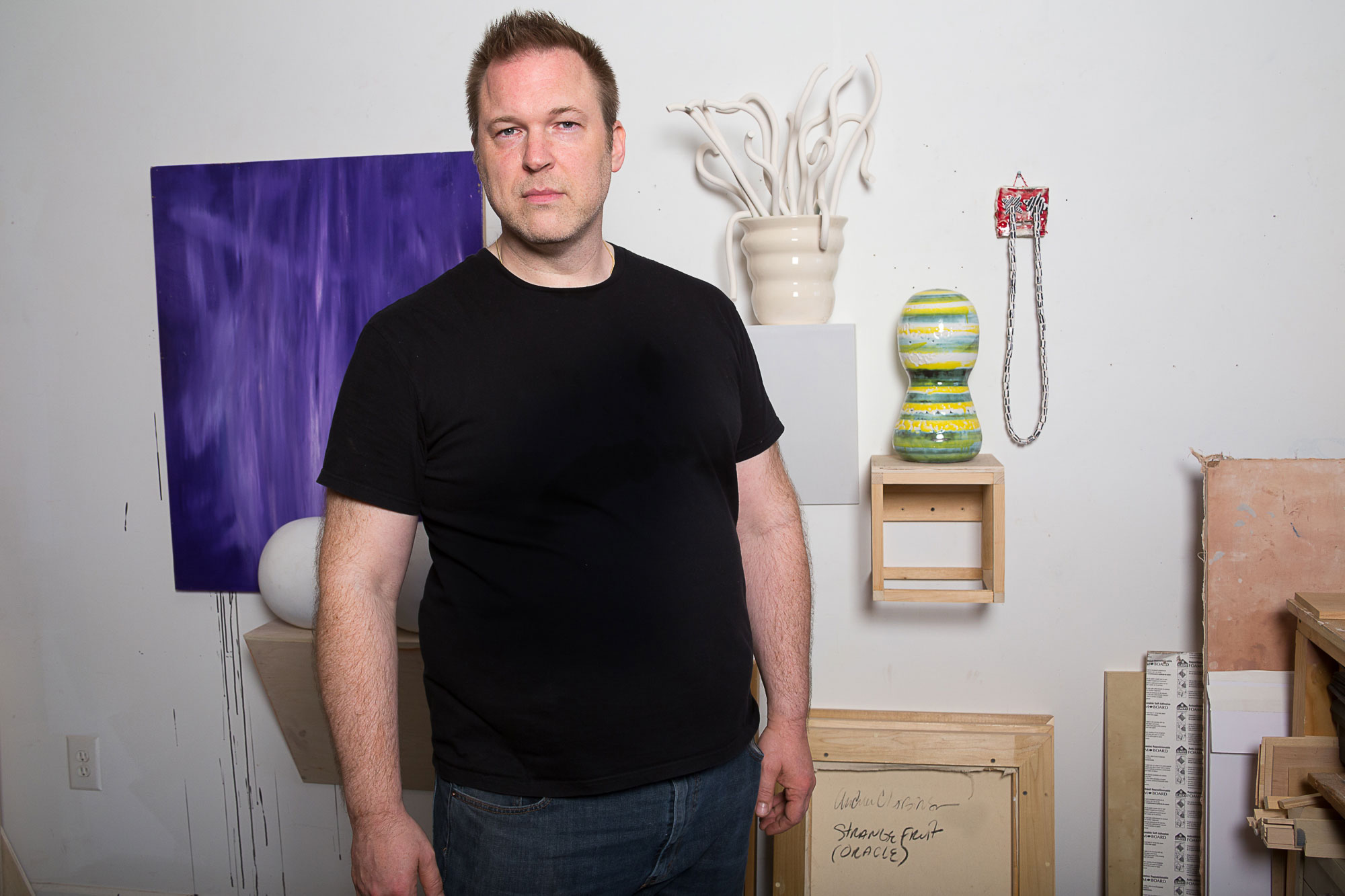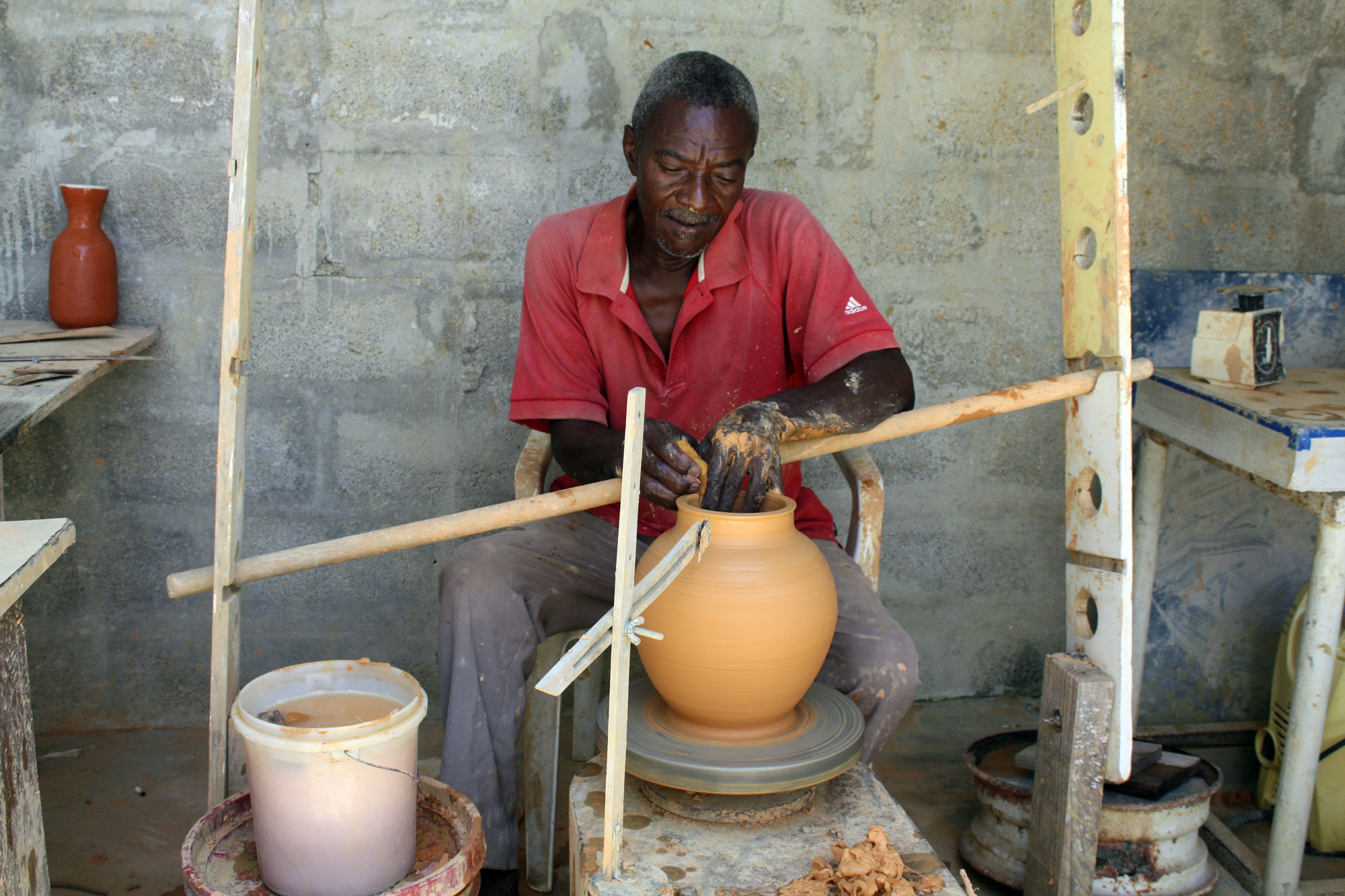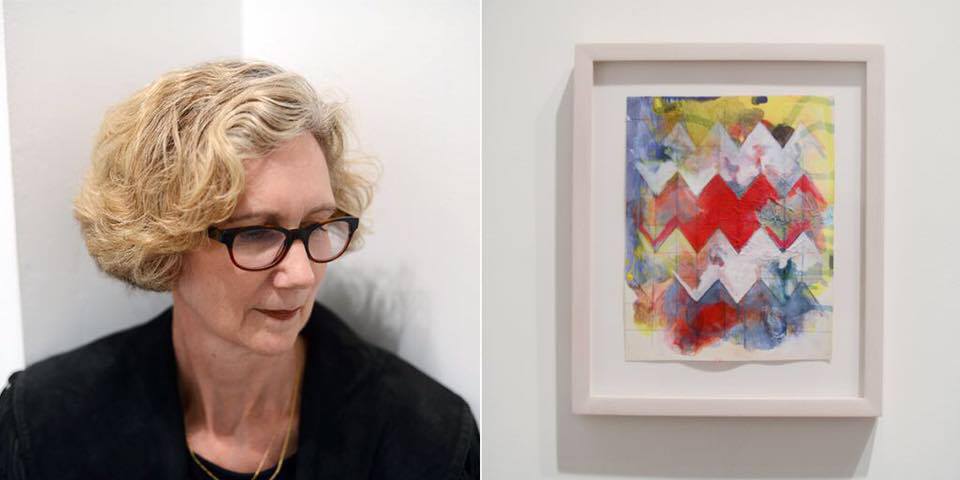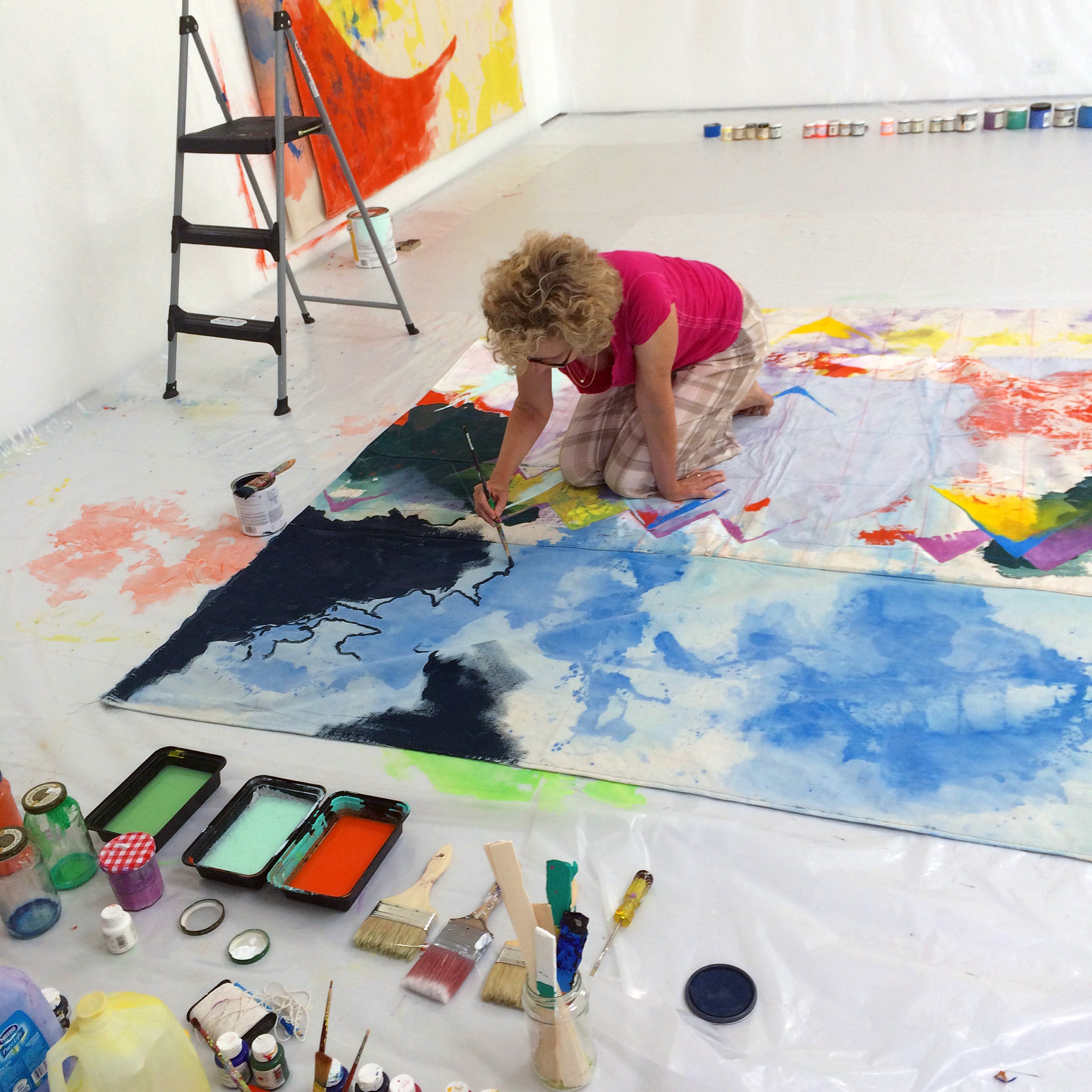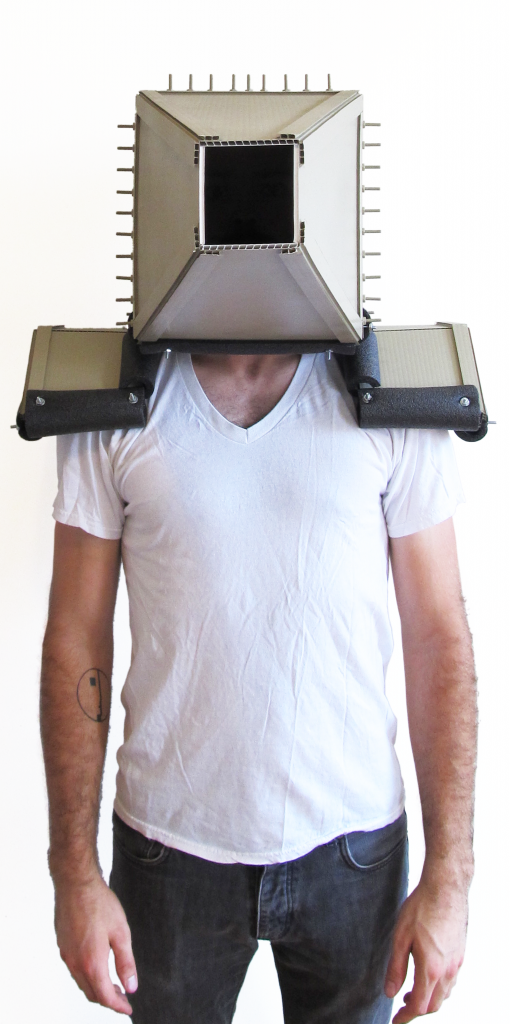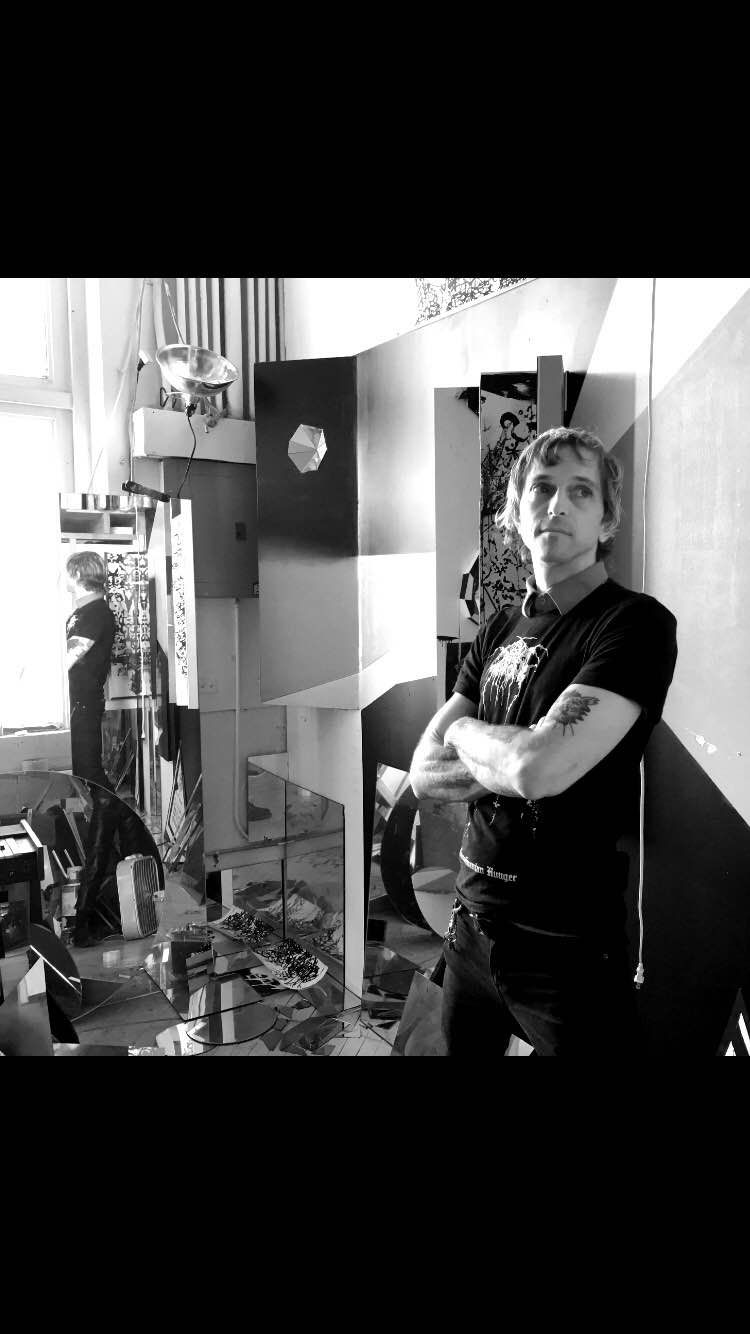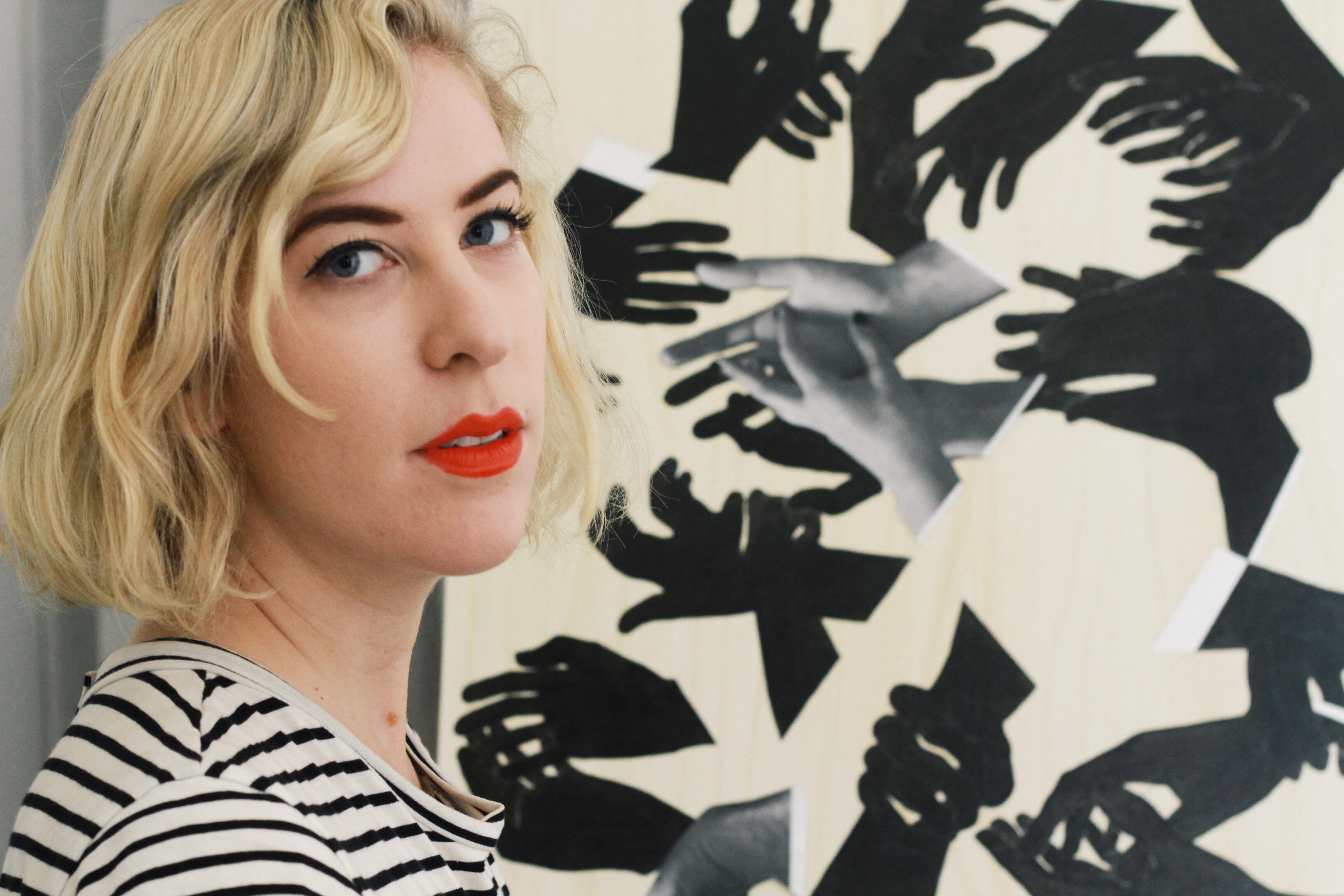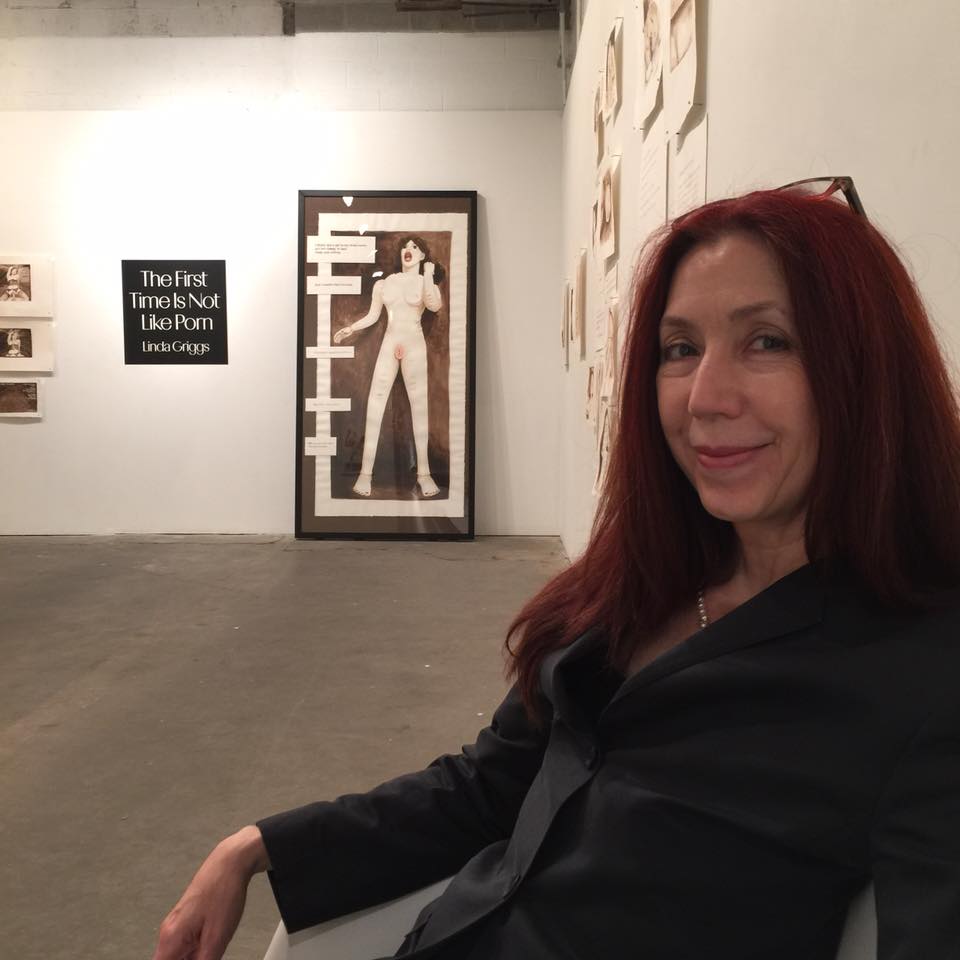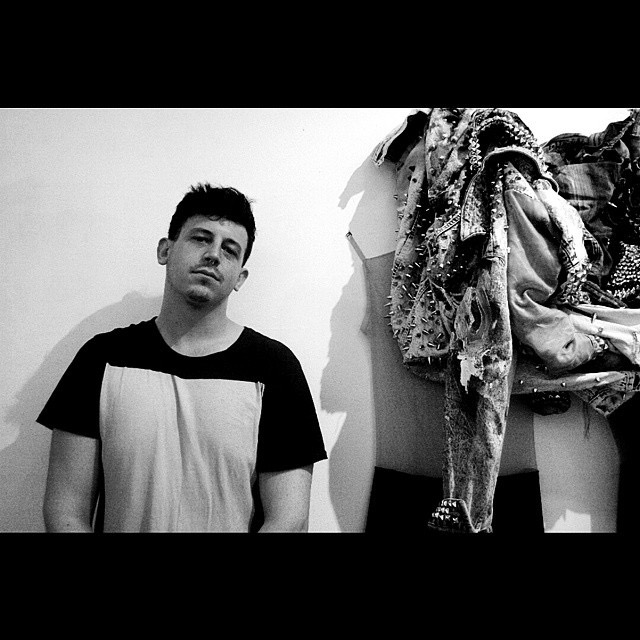Christopher Stout Gallery is a new art space located in East Williamsburg that opened its doors this Fall 2015. Self-described as “showing subversive and difficult work by New York City artists, [they] “delight in serving as a platform for discourse on work that is challenging to authority paradigms, feminist, queer, anti-establishment, hyper-aggressive, mystic, and/or joyously sexual.”
Stout is an artist himself as well as the the founder of Bushwick Art Crit Group, an organization that hosts monthly artists lectures, panel discussions, exhibitions, and more.
In an effort to learn more about the new gallery’s mission and represented artists, I asked Stout as well as each represented artist a series of questions about their work:
Christopher Stout
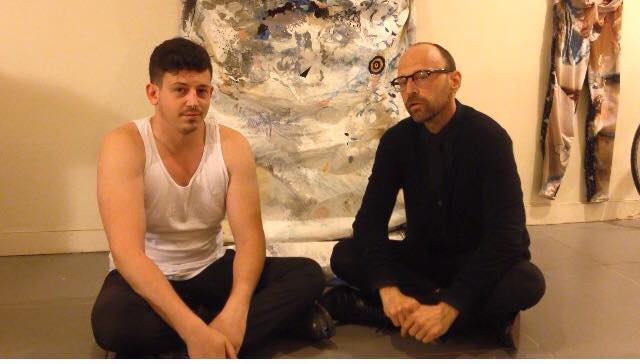
“We consider this gallery to be a new chapter in art that has spanned decades in New York City, and is exactly the type of work that makes this city a global center for visually expressed philosophical thought.”
What inspired you to found the Bushwick Art Crit Group?
Bushwick Art Crit Group started as a way to combat the isolation I felt of working alone in my studio. I was feeling stuck by the dichotomy of being in the center of a very celebrated “working artists” neighborhood and yet not feeling connected with my people. I went to speaking groups in the Lower East Side, and wondered if forming a lecture series in Bushwick might fill a need state that wasn’t being addressed.
Our lecture format is that each month, 5-6 artists share 10-minute talks with our audience about their work, showing images via digital projector and answering questions. Since the beginning, we’ve dedicated our marketing efforts for these talks specifically to galleries, curators, collectors, museums, auction houses, and the art media. We’re not running a grad school exercise; this is about development within our community.
Can you tell our readers a bit about the mission behind your eponymous new gallery? What does ‘subversive’ and ‘difficult’ mean to you?
To be certain, there is a sort of wonderment about heading up an art space with your name on the door, however the words “New York” are probably the MOST helpful in relation to our mission statement.
“Difficult and subversive” art has been made in New York City in earnest since at least the 1950’s. As much as our mindset is about exploring the future, we are also holding up an important dialogue with the past. We consider this gallery to be a new chapter in art that has spanned decades in New York City, and is exactly the type of work that makes this city a global center for visually expressed philosophical thought. Sexually overt art, queer art, feminist art, sociopolitical art, art the challenges authority models: all of these dialogues are celebrated as essential parts of the history of Contemporary Art, and more-than-ever needed in the present, and in the future.
How do you choose and find your artists?
In many ways the gallery is a conduit of taking all the various art fair and visual curation projects that happened as part of BACG and narrowing our focus into a specific kind of work. All of our “Bushwick” centric exhibits were about including work from all of the artists who lectured with us, however the gallery was a way of being able to focus specifically on artists I had worked with at BACG who had the ability to incubate our specific visual program.
Brian Andrew Whiteley
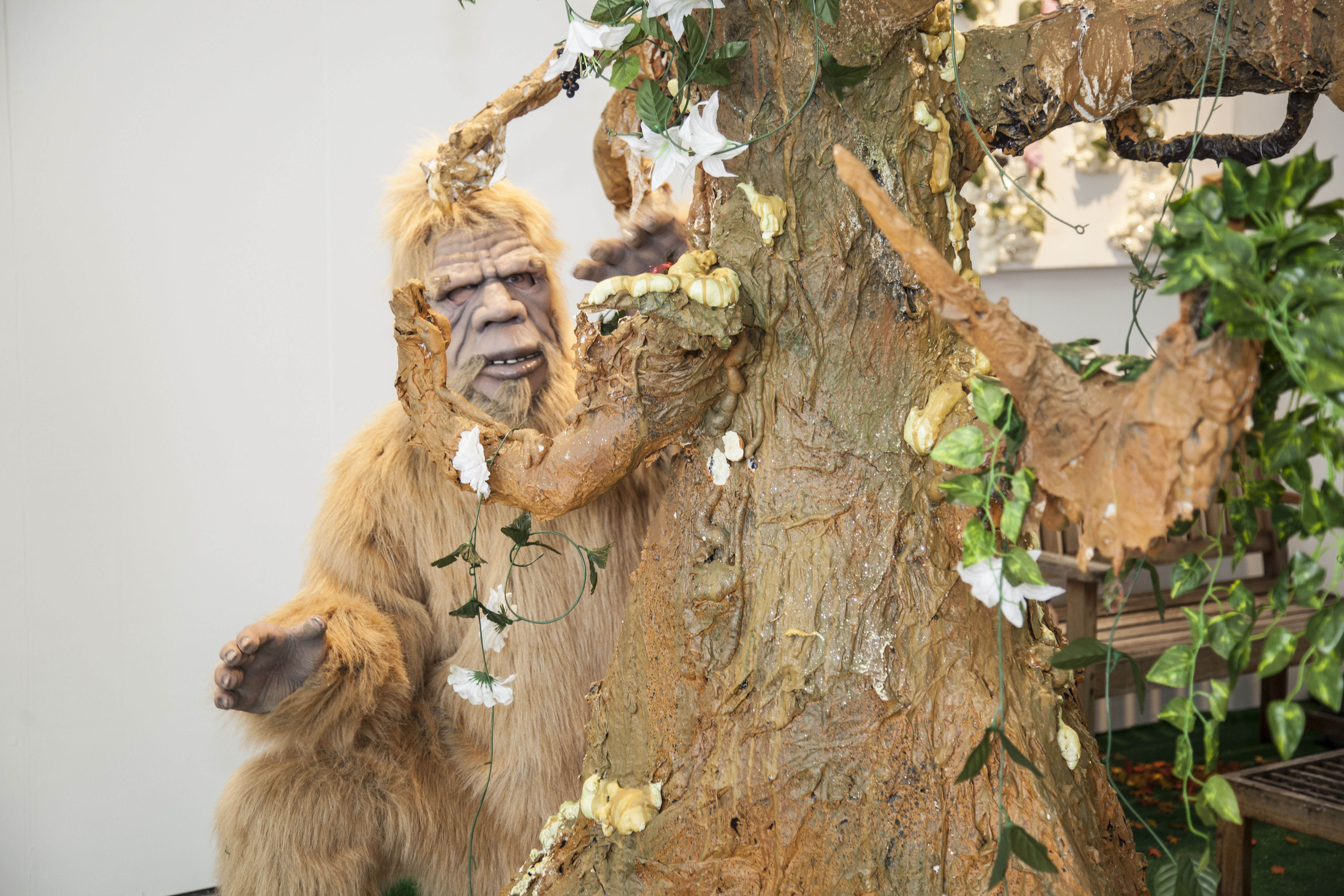
These characters are a portal of escape, a gateway to a secret identity.
How do you choose the character-archetypes you embody?
Generally speaking, I choose characters that are universally known, but whose “Life” has not been fully fleshed out. I find a lot of creative freedom in shining a light on those grey areas, providing new insights into their activities. Where does the clown go for a lap dance? What would a clown make for a painting? Where does bigfoot go for glamour shots? Does he go on dates?
How does immersing yourself in different worlds help to inform your practice?
These characters are a portal of escape, a gateway to a secret identity. You have a green light on being silly, sexy, scary, funny and absurd – many things that as a regular adult you cannot fully embody. Additionally I’ve begun reaching out to fellow clowns and bigfoot aficionados, you wind up getting into some fascinating conversations that help to direct the focus of your work. Bigfoot experts in particular are extremely fascinating to me lately, their stories and beliefs are absolute and unbelievable, and goes directly into what and how I create.
What does ‘the clown’ represent to you?
I went to summer camp when I was 12 and was allowed to choose my own activities for the summer. Out of a number of activities (including many that were sports related), I chose clowning, miming, and entomology. Sometime during that summer I also hit puberty, strange new sexual feelings in collaboration with make-up and clown regalia soon turned into a distinctive kink. There are numerous elements of ‘the clown’ that get me going…but it is mainly the balloons, the fabric and anonymity that really turns me on. It was a natural transition in bringing my clown character into the studio, and one that I am surprised hadn’t happened earlier. Prior to working through the clown as an artistic medium I was a clown for hire, something that I still do for select events.
So long story short, ‘the clown’ is my wacky, sexy secret.
Andrew Cornell Robinson
Your website describes you as “driven by ideas, craft and material traditions.” What is it about drawing from historical technique that interests you?
My fascination with craft techniques and traditions is not entirely limited to historical or technological anachronisms. I am interested in the empowerment that is endowed with vocational and kinetic engagement with the world. We (humans) make things. Craft and ceramics in particular are at the core of my own experience as an artist, designer and even as an educator. Plainly stated I think there is value in learning how we might respond creatively to our world through a balanced embodiment of mind and hand.
I have come to believe that humanity, especially in the industrialized world, has continually stumbled over itself in a false dichotomy between the mind and body. Ideas – perhaps introduced by Plato and surely reinforced by judeo-christian belief systems – fixated on sins of the flesh and salvation of the soul and intellectualized by René Descartes’ Dualism and reflected in contemporary social and cultural practices attempt to separate thought from action. Just as Descartes separated and demarcated the rational subject from the objective work, economists and management thinkers over the years have also separated the rational mind from the tasks being managed. [1] The result is a sequence of soul crushing and impotent actions from “liking” empty promises on Facebook, which passes for social or political engagement these days, to the mechanized sweatshops of our recent industrialized past. This Cartesian divide gave way to the mechanization of work through Taylorism, a system of scientific management advocated by Fredrick Taylor. He thought that a manager’s task was to remove all decision making from the worker’s job by breaking down a task into individual motions, analyzing them to determine which were essential, and timing the workers with a stopwatch, to find the most efficient way to accomplish a job. With unnecessary motion eliminated, the worker, following a machine-like routine, became far more productive and perhaps a little bit dead inside.
So my interest in historical technique or more accurately in craft and hand work from painting and pottery to changing a flat tire or cooking a delicious meal for a friend are a reflection of my interest in empowerment through engaging simultaneously with our bodies AND our minds.
You now run acrStudio that encourages collaborative projects. One that stood out to me was your recent invitation to work on a project in Haiti with the DOT center (Design, Organization and Training), the vocational training center in Port-au-Prince. Can you tell us about that experience?
I feel fortunate that I was invited to collaborate with Haitian artisans and designers in the establishment of a ceramic studio in the DOT center. While I was there I met several local ceramists, jewelry designers, sculptors and craftspeople. I led ceramic workshops focused on food safe glazes, surface decoration and techniques. I also worked in consultation with DOT staff and visiting design fellows to help them set up their own ceramics studio.
I spent part of my time working with the ceramist Marithou Dupoux. I visited Marithou’s studio, we did a Raku firing and explored several different glazes she was working with. She makes wonderful and rich metallic glazed surfaces and the clay she uses is plastic and terrific to make wheel thrown pottery. She and her peers travel into the countryside and dig clay out of the earth. She has a huge pit of clay behind her studio that is the color of mustard. An ochre yellow when wet, the clay fires to a rich earthy terracotta, turning red from the iron rich native clay. While there may be some challenges that she and the other artisans face with regard to getting materials, tools and access to markets and capital to support their creative work, there is an ingenuity, entrepreneurial and creative spirit that offers a power of example of how craft and design can impact a person and their community both economically and culturally.
The experience of traveling to a new place and having the opportunity to get outside the bubble of a hotel or a chaperone can be incredibly enriching. For example one day when my host was planning to take me for a day trip to meet some metal workers, she got a terrible case of food poisoning from the meal we had shared the night before. I was picked up instead by Junior, a man who spoke little English (and my French is elementary at best), so we spent a day driving around Port-au-Prince, gesturing, drawing, laughing and exploring villages, markets and bearing witness to the rubble that is the downtown, still recovering from that terrible earthquake that had shaken this island nation. One particular stop was remarkable to me; Junior dropped me off in the middle of a commercial street and left me there in front of a shop where a group of men were making some of the most beautiful jewelry and table top accessories ranging from bowls and spoons to objet d’art made from goat and cow horn. Their tools were rudimentary, and with electricity being an inconsistent resource in the city, they skillfully used their hands to render this crude material into highly polished surfaces, rich and lovely to look at and touch.
It would be so easy to visit a place like Port-au-Prince and as an outsider cushioned by my white-privilege, look upon the poverty, corruption and devastation in the aftermath of an earthquake and the social and civil discord that seems all too prevalent and feel overwhelmed, retreating quickly to the comfort of a hotel. And there was a moment when I felt all of that, and yet when I was blessed with a chance to meet locals in their workshops and homes, to share a story, a cup of coffee, to break bread, make a pot, or fire a kiln, and share a smile, this world opened up to me just a little bit. I found the Haitians who I met to be an incredibly generous, industrious and creative folk. I went down there as a teacher and I came away myself having learned many lessons from the power of their example. The artisans who I worked with embodied craft, creativity and a sense of community in their work and warm welcome.
What is in store for the future?
I am currently working on the creation of a new project that explores the lives of revolutionary characters loosely based on Charles Dickens’ novels such as A Tale of Two Cities and Great Expectations. I often employ design methodologies such as the creation of a “design personae”: an archetypal character that I create by writing a story so that I can identify their characteristics, goals, needs, desires and attitudes. I then use the persona to facilitate a series of collaborations with others that may include artisans and designers, to musicians, technologists and poets, et al and I work on the creation of objects and artifacts about and for that persona.
I am currently working with a fashion designer on the creation of a corset and gown for a female persona loosely based on Madame Thérèse Defarge, an anti-heroic character in A Tale of Two Cities. Defarge is a tireless worker for the French Revolution obsessed with revenge against the aristocracy. Dickens introduces her sitting quietly and knitting in a wine shop. Her apparent benign passivity belies her relentless thirst for justice and vengeance. With her stitches, she secretly knits a register of the names of the enemies of the coming revolution. I am using this image as a departure point to create a hand sewn garment that I will wear when I embody the persona. Instead of knitting, I will explore embroidering the names of a contemporary aristocracy alive and well today. The character will operate as a muse, which will enable me to create a series of images and artifacts for her. Using this same methodology, I am simultaneously working with a product designer to employ three-dimensional printing to create a series of grotto-like forms that will eventually be slip cast in ceramic and accompany the embroidered garment and related imagery.
The work itself converges around the aforementioned personae but the result may take an independent or collaborative pathway, it may take a narrative, theatrical or even an abstract turn. While the process begins with a story, a conversation and action, it is my belief that by bringing both mind and hand together we can create something new maybe even something wonderful. You can see the fruit of this current project come together in an exhibition in March 2016 at the Christopher Stout Gallery.
[1] Magalhães, Rodrigo. Organizational knowledge and technology: an action-oriented perspective on organization and information systems, pp. 222. Cheltenham, UK; Northampton, MA: Edward Elgar Pub. 2004.
Anne Sherwood Pundyk
“By the concrete, direct nature of its creation, connecting consciousness with hand and eye, painting engenders an appreciation for the virtue of a changeable, independent mindset.”
What is your revolution?
My motto is “The Revolution Will Be Painted,” which is inspired by Gil Scott-Heron’s 1971 poem, “The Revolution Will Not Be Televised.” Scott-Heron’s piece refers to the insufficiencies of the medium of television to convey genuine transformation. In contrast to television, or any of the media currently proliferating that can be invisibly co-opted, painting has ready access to individual truths. By the concrete, direct nature of its creation, connecting consciousness with hand and eye, painting engenders an appreciation for the virtue of a changeable, independent mindset.
What power do you feel comes from “the communion between artist, subject and audience”?
In his Critique of Judgment, Immanuel Kant examines the requirements for determining Beauty. One key component is “an aesthetic quantity of universality or validity for everyone.” This idea conveys a sense of the power of the inter-connective flow between an artist and the subject she chooses to convey her ideas and the audience for the artwork. I believe the body is both the source and destination for this communion. I am currently exploring how the abstract qualities of color and form in painting convey powerful messages read through the body.
Is there a project you’ve worked on this year or will work on that you’re really excited about?
For the last five years I’ve created provocative, feminist performances and a publication called “Girls Against God,” with Bianca Casady. After over two decades working in New York City, I recently moved my studio to the country on the North Fork of Long Island. Now that I am subsumed by nature my paintings are connecting their wild energy with my activist urges. For my solo show with Christopher Stout Gallery, New York in the spring the monumental, my abstract paintings on unstretched canvas use color to create a new theatre of space. I have a second solo show at Adah Rose Gallery, Kensington, MD this spring where I will be showing smaller talisman paintings which harness the same forces.
Eric Gottshall
“I thus made it my mission to create objects through which you discovered the real artwork – that being yourself, the room, the light, and the dialogue continuously happening between all parties.”
Where do you believe your fascination for modes of observation came from?
Looking at artists like Mark Rothko, Barnet Neumann, and James Turrell, I quickly became enamored with the way in which they were able to charge the environment around their artworks. It was a breakthrough to think that the art was truly the spatial awareness and introspection of the viewer, as facilitated by the painting. In the case of Turrell, it was his ability to take something seemingly secondary, yet displayed in a very tangible sense its physicality. I thus made it my mission to create objects through which you discovered the real artwork – that being yourself, the room, the light, and the dialogue continuously happening between all parties. Discovering these elemental, yet fantastically dynamic scenarios has continued to be my fascination. Furthermore, I believe it to be incredibly important to decontextualize a place like New York City. To take a participant, and for just a moment, force them to question everything they know about their relationship in a given environment.
Do you draw inspiration from any particular artists?
As I said, Artist like James Turrell, Donald Judd, John Cage, Mark Rothko, Barnet Neumann, Richard Serra, are all people with fascination in the introspection of the viewer. These are the artists who initially sparked my fascination with minimalism, and it’s infinite possibilities. In a wearable sense, I of course look a lot at Nick Cave and his ability to give performers full freedom in their environmental rediscovery.
What is next for you?
I feel there is still much to be learned from my helmets, thus I plan on taking their production much more directly into the avenue of film and performance. Only through wearing these contraptions amongst other participants will I know what the next logical narrative can be. I would also like to expand to sensory altering full body suits, removing the primary focus from visual alteration. I’m also fascinated with the collective conscious, and plan on creating wearable devices that link multiple points of observation.
J.Morrison
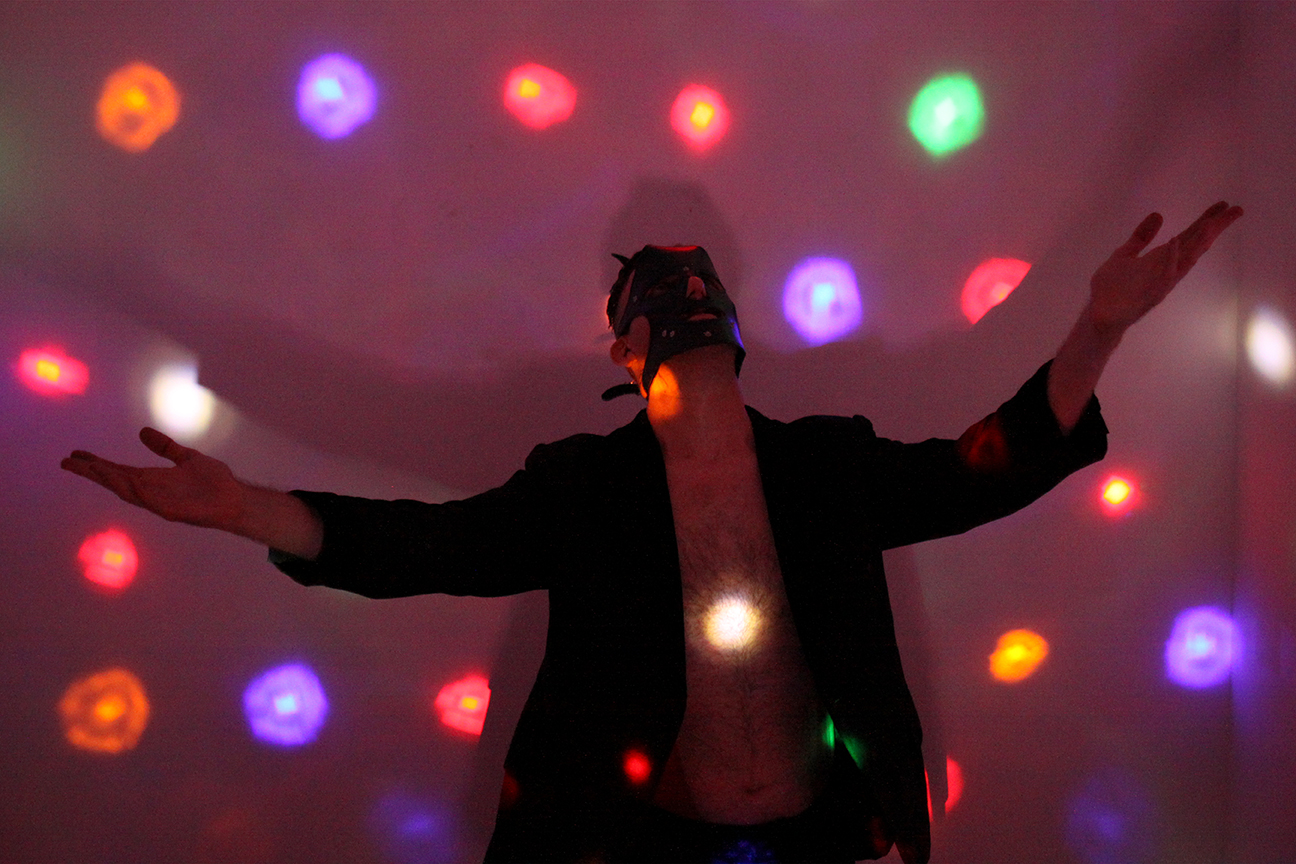
“…the participants are asked to let go of as much as they are willing, and then the piece is about our shared experience created through the work.”
Many of your performances involve viewer interactive participation. What do you seek with this inclusion?
My “Escape From New York” performance series deals with escapism. The 3 installments have been performed for one person at a time. Essentially the participants are asked to let go of as much as they are willing, and then the piece is about our shared experience created through the work.
What is it about the style of filmmakers David Lynch and John Carpenter that appeals to you?
Mystery, intrigue, confinement, and their ability to create a new world/space. Also their spirit of playfulness, humor and fun.
Are there particular themes you are inclined to explore?
Fantasy vs reality, removal and escapism, lightness and darkness, loss and hope.
Josh Kil
How do you investigate meaning in a broader context?
I try to be aware of the tautological quality of meaning, or at least what we often consider to be meaning. Definitions mostly rephrase or describe the denominated. I love attributions within the occult, because they seem to go forever; lavender is Jupiter is Thursday is Zeus is blue is ATU X is Fortune is amethyst is kaph is a fist is path-21 (2+1=3) on the Tree of Life…. it just keeps going, and you still never find out what amethyst means, but maybe you can get the impression that it’s a good thing. (See the table of correspondences in 777 by Aleister Crowley.) In my work, I try not to get too bogged down with the fractal spiraling and telescoping but try to be aware and let it happen, knowing also that the most meaningful moments are probably the most nonsensical seeming, like moments of emotion that are triggered by a color next to a shape, or a rock on top of piece of paper.
What is the importance of text in relation to your drawings?
Depending on the drawing, the text might not even be legible, and that’s perfectly correct. Whether words, text, lines, abstract or automatic drawing, they are all part of the formula of the thing to be; which is completed by the viewer. The viewer might see words or faces, provocation or humor. It’s important to me to have a sense of the continual becoming status of a piece. I do, however, think it’s important for the viewer to have some hint of a language, process or code that has informed the direction or trajectory.
Your photo work is incredibly film noir-esque and seems to portray heterosexual tension, duality, and the (primarily male) gaze. What are you exploring here, and why?
The piece titled “Spy” that’s in the current show “Skin in the Game” is an interesting piece to bring in the discussion of the gaze. I suppose it’s accurate to call it a heterosexual tension, but hopefully the sexual tension translates regardless of sexual preference.. The fact that it portrays a male and female having sex does narrow it, of course.
There is, no doubt, a gaze, but it’s specifically voyeuristic. My girlfriend and I came up with our kinky plan to have the encounter with a young man she met from Tinder. It was not filmed with the intention of being particularly film noir, because we weren’t concerned with aesthetics. We weren’t making art. I did edit it, and we both agreed that it could become art, but the quality really evolved from the unintended lighting and effects of using my phone camera through a little peep-hole.
“The gaze” is coming from multiple angles, and the dirty little trick is making the art viewer a voyeur in a way they are conscious of by literally reflecting them and the surrounding room in the mirror. I think it’s beautiful how it becomes art, complete with all of her aesthetic and socio-cultural properties.
It’s an interesting piece to exist in the world, and it wouldn’t be as effective if it were planned out from the beginning. It’s provocative and beautiful and raises a lot of questions.
Kelsey Shwetz
How is painting a useful tool for you to challenge social norms?
Painting as a language has a considerable arc, for much of its existence it has been used specifically to shape societal values and inform standards of beauty and what is divine. I wonder if in some ways painting still has the ability to inform our ideas about what is ideal, aesthetically and socially. And so I make figurative work that re-enters experiences and things that the bodies in paintings—and bodies everywhere—have been feeling and doing and experiencing all along, but because of the oppression and censorship of “non-normative” sexual expression, and the censoring of women’s bodies and sexuality particularly, have not been widely treated in painting.
How do you choose your subjects?
Short answer would be “experientially.” Most of the subjects I’m treating, like the female gaze, menstruation, and expressions of sexuality, fall within the range of personal experience and the contexts that I place these subjects in are closely knitted to the original situations that I’ve experienced them. I’ve often had models try to replicate specific feelings or situations, but sometimes the model themselves (who is always someone I have some kind of personal relationship with) and their own personal narrative determines the subject or mood of a painting.
What are your plans and goals for 2016?
I have a residency in January at Eastside International in LA where I’m planning to complete my first large work in a new series I’ve begun. Whereas I previously focused on the relationships between a body and society, or a body and another body, I am now concerned with the relationship between a physical space as it exists in one’s mind and an abstracted aspect of a person. This new body of work will determine the coexistence of figurative elements and interior or exterior spaces that I have inhabited or that hold personal meaning. I am interested in arriving at a balance, or a visual point, where each object in the painting (staircase, arch, gesture, limb) both contains and informs the significance of the visual space surrounding it.
Painter friend and director or A.I.R. Gallery Jenn Dierdorf and I have begun to host a series of Painters Parties, where we invite self-identified women painters we admire to gather and share about their work. In 2016 I’d like to expand the criteria and extend the invite to artists working in other mediums.
Speaking of other mediums, a big goal of 2016 is to make a short experimental film with my partner who is a filmmaker. I’m terribly excited to become familiar with this new language of film and make imagery that is not static.
I have a solo at Christopher Stout Gallery in May where all of my new work will debut! I’d also like to curate one show in 2016, either with the other members of curating collective Studio200 (Lara and Aubrey Saget) or independently.
Linda Griggs
“Even if you only curate one show you can learn to appreciate the hard work that’s being done on your behalf and how to best assist rather than detract from those efforts.”
You draw from many places and include links along with your work to art historical references, classical studies, etc. What is your process when embarking on a new project? How do you choose your stories?
Like a lot of artists I decided on a topic and work on a series of paintings. Once I have a topic in mind I start chatting with friends and strangers on buses, etc. and see if the topic reminds them of a story they can’t resist sharing with me. If it does then I know it’s got some universality and if I’m lucky I get a good story too. Then I do my best to get the story down as concisely as possible, run it by the original teller for veracity and take it to my very smart writer friends for editing.
Then I start finding images or combinations of images that will add to the story without being illustrative. That’s not always easy but there has to be a space between the image and text for visual puns or the viewer to bring his own interpretation.
I was taught that illustration should be quickly understood before the page was turned, and art was for a lifetime of contemplation. Obviously, there are artist who can walk back and forth over that line – Sue Coe, for example – but I’m dismayed by the amount of illustration that’s being served up as art in the galleries.
The Narrative Still Life series included so many puns and references that I couldn’t really expect the gallery staff to know them all so I made a book to accompany the show. For one painting, Communion Ruminations I found so many hilarious images I made a book just of that. Same thing with the Barbie Cake painting.
My current series, The First Time Is Not Like Porn is more straight forward. The subject was so intense that just contrasting people’s real feelings about their first time, sexual experience with images from porn was enough.
Usually my finished work is painting on canvas over panel but for this series all the work is done on Rives BFK paper in Black Walnut ink which I make myself. I didn’t feel like they needed to be paintings. The images which are all from the internet had an ephemeral feeling and paper lent itself to that. The ink is sepia colored, the color of nostalgia, and lent itself to the depiction of memories but I’m not illustrating the memory of the story teller’s first time sexual experience at all. For the most part I’m using the sepia colored image from porn to describe the memory an unreasonable expectation.
Some of the stories are from the internet and I make that clear by including the story teller’s screen name in the text. Some are from friends and strangers. For example, Xopher, is from a friend. The first image is of one of an African American, porn star dressed in a thong and heels, a cliche of lascivious attire, and the contrast between that and the description of the real life, very sweet, Black girl dressed in a brown plaid, polyester restaurant uniform is hilarious. I’ve worn those uniforms. Mine smelled like pizza and cigarettes. Sooooo not sexy.
The second image is of a man tied down, spread eagle. He forms an X and that X pins down the composition. Since Christmas is abbreviated by an X for Xmas and the story teller’s name is Chris I titled it Xopher, a pun that amuses me and probably no one else.
The third image of ligature marks on a wrist after bondage was also from the internet. But I changed the position of the thumb to ‘thumbs up’ since the story teller managed to put a stop to his mother’s accusatory interrogation.
I’m trying to decide now if my next series should be “Bad Toy” or “The Worst Ass Whipping I Ever Got.” There’s actually an overlap between the two in Hot Wheels tracks which more than one mother has used on a kid.
What was your most significant project / exhibition of 2015?
My most significant project was All | Together | Different: A Survey of Working Artists on the Lower East Side which I curated with Yona Verwer. It was considered by some to be important and historic. I brought over 100 artists and organizations together and reminded them that the LES was still a place where artists lived even as gentrification overruns the character of the area.
My most significant exhibition is of course my solo show, The First Time Is Not Like Porn, which is up now at Christopher Stout Gallery, NY. Having a solo show makes it significant to me but the location is important too. It’s not just a gallery. Christopher has a strong sense of community and it sets the tone for the way the gallery artists deal with each other and this feels like art family, like cousins in the most wonderful sense.
Are there parallels between the way you curate your own work and the way you conceptualize a group show?
There is a parallel in that with both I put images together to create a narrative. That’s a natural thing the human brain does anyway but it’s something I especially enjoy since I spent summers in the south where story telling is cherished.
Ideas for group shows come to me when I see a trend happening. This is why I love the art fairs in Miami. A year’s worth of art is all right there and after spending the day looking at it I can have a cocktail, stretch out on the beach, relax into a dream state and contemplate why certain works stood out for me and why I think they relate to each other. Those images start forming a narrative about cultural concerns or aspirations.
Once I have a theme or theoretical imperative in mind I have to be careful that I don’t turn the artists’ work into an illustration for the show concept or change the meaning of their work by including it.
Curating also really helped me learn about installation. Placement of the work in relation to the piece next to it, both visually and conceptually, is so important. You can make good work look bad just with poor placement so I layout the show to scale in Photoshop.
During All | Together | Different I did have an artist get mad at me for not rearranging my layout for the show so he could put in a larger work. He had curated the kind of shows where all the artists just show up with a painting and a nail. He scoffed at my careful layouts and said I should be more flexible. So I especially cherished the compliment I got from the head of the Metropolitan Museum of Art Costume Institute on the way so many different kinds of art could flow together so well.
You might think that with my own show I’d have no trouble with layout. But if actors can’t generally direct themselves then why should artists think they take an objective view of their own work?
For example, I noticed when I curate that sometimes artists will want to show a piece they’ve agonized over and finally beat into submission thinking it’s the best when the one I like is the one that came easily to them, that showed their mastery of the materials and ideas. I got worried that I would do the same thing when it came time for my own show.
I have never regretted turning to people I trust for quality control and a second opinion. When I was working on my solo show for Hampden Gallery, UMASS Amherst I had a chronological layout. Alix Sloan came over and said that artists always want to do that and it usually doesn’t work. She looked at the layouts, reordered everything, and it was like the scales fell from my eyes. It was so, so, so much better.
For my current solo show, Christopher Stout and my husband, Allen Hansen, both contributed to the flow, layout and installation of the show. It’s a beautifully installed show, exponentially better than anything I could have done alone.
I’ve learned so much from curating shows that I often recommend that every young artist curate a show at least once. Artists can be unwittingly self sabotaging but looking back on my own behavior as an artist I have to laugh because can see that I was too. Even if you only curate one show you can learn to appreciate the hard work that’s being done on your behalf and how to best assist rather than detract from those efforts.
Vincent Tiley
“I still cling to my outsider status. If I go out wearing my harness I want everyone on the street to think ‘Oh he’s one of those weird gays’ and take the extra steps to get out of my way.”
How do you queer the relationship between the self and the body?
The body, identity, and self all inform one another but definitely are not equivalent. There are certain expectations that a society might have of a person because of their body. Queerness is just one of the ideas that exists as a method of undoing those expectations. As queers we often use clothing and grooming as methods of expressing or becoming ourselves in both public and private spaces which is why a lot of my work focuses on garment. Drag, dandyism, butch, androgyny, etc are all very established ways of dressing the body’s outsides to convey or disguise the self underneath. I’m often trying to pay homage to this queer act of getting dressed every morning. However I’m also trying to reimagine the self through garment by making these bodysuits for impossible and collaged bodies made up of many bodies. In doing so I hope to destabilize the idea of a singular and constant self that resides in the body and that these two forces are never at odds with one another. I want to replace that with the idea of a transient, dynamic, mutable self that like the body it resides in is constantly absorbing and expelling its surroundings.
Why are durational performances important to you?
To a certain extent it is about this objectifying experience of being looked at and the information that can be gained from looking at person. My performers are made objects by their audience, that’s why the work is very still. However the gaze is being directed away from the body and identity of the performer by this suit that’s being worn. The performer is acting as a sculpture and painterly surface though their breathing and attempts to get comfortable are a reminder of the person inside. This can’t really be accomplished in a 20 minute moment on stage, they have to really be there and occupy space. If gender and other aspects of our identity are performed for ourselves or for others, then my work actually seems quite short by comparison. Everyone is familiar with endurance, sometimes it’s enough work just existing. I’m also trying to subvert audience expectations of being entertained by performance. These aren’t shows you have to stay and look at the whole time. People get bored and walk away, which I think is incredible. It really speaks to the power an audience has in a performance or (any situation really), that a person can do something simply for sake of being looked at and the other doesn’t necessarily have to look. At other times people get drawn in and really study the performer and look at how they are restrained or interacting with other performers or objects as part of this new body. Either way the audience is a part of the piece. It can’t exist without looking. Even if no one is there the performer is still there for you, you’re still implicated.
What drives your fascination with voyeurism and fetishism?
As artists I think we are always interested in different ways of looking. Voyeurism is just one way of looking that I’m fascinated by, although it is often one that is helpful to me. Of course it goes hand in hand with fetish. Fetish is really interesting because it functions so linguistically. Certain articles of clothing or gear are cues for other people to respond. They point out what they might be seeking in a sexual interaction and levels of power or control they are willing to relinquish. Also a man in the gay leather scene may wear a harness or a leather jacket as a prosthetic for an idea of masculinity and power that he might not live up to had he not dressed the part. But fetish garments are all about what you can see and what you can’t see. They are about displaying the body and putting the body in a frame. They control where your eye goes. Which is something I often am trying to do.
Chaps and jock straps frame the ass, harnesses divide the torso into anatomical sections with black leather lines, and zentai suits cover everything, they are so coy. That’s why my suits usually resembles zentai suits. Zentai’s completely articulate the edge of the body while making it impossible to look past the surface. Then if I choose to reveal something either with a cut-out or sheer fabric it feels like a secret, the audience becomes voyeur. Fetish is also something that culturally symbolizes outsider status. I think that’s why so many gay men in New York today are walking around in harnesses and collars during daylight hours. We benefit so much from society today and there is a real fracture between many conservative gay men and their more liberal counterparts that are less willing to sell out the rest of the queer community.
There are still many of us that don’t want to be adopted into a mainstream cis-hetero-white society and paraded as a token of the “progress” that society has made. I still cling to my outsider status. If I go out wearing my harness I want everyone on the street to think “Oh he’s one of those weird gays” and take the extra steps to get out of my way.
Christopher Stout Gallery, New York
299 Meserole Street, Ground Floor Rear
Brooklyn, New York 11206
Gallery Hours: Thursday through Sunday, Noon-6:00pm and also by private appointment.

